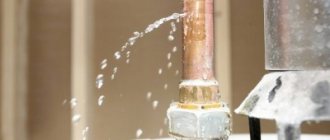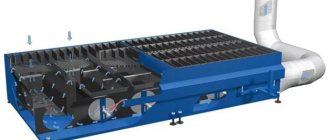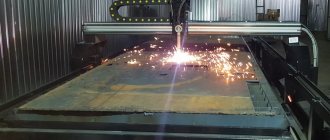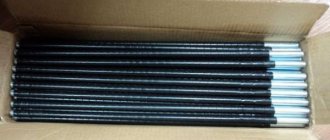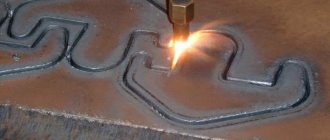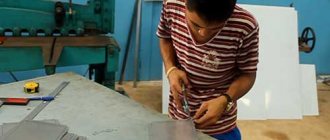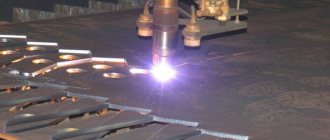[Waterjet cutting of metal] is a technology that the engineering and metal rolling industries cannot do without.
Sometimes it is impossible to achieve the required cut quality even through plasma cutting, which is why equipment for cutting using a waterjet is used.
Waterjet cutting of metal was first used by an American aircraft manufacturing company, which subsequently presented evidence that this technology is the best option for processing steel and other refractory metals.
Since that time, the water-abrasive method has not ceased to be in demand in various production areas. Today, machines whose purpose is to process steel, pipes, etc. with a waterjet are very popular.
Construction of a waterjet cutting machine
Waterjet cutting machines are used in cases where it is impossible or not profitable to make parts by stamping or casting. It allows you to cut materials without the use of a mechanical cutting tool. The material is cut using a jet of water with abrasive additives, which is fed through a nozzle under high pressure. The advantage of this method is that you can cut at any angle, you just need to adjust the angle of the nozzle.
Water with abrasive is supplied under enormous pressure from 200 to 600 atmospheres and is capable of cutting materials of any strength:
- ferrous and non-ferrous metals, their alloys;
- stone (marble, granite);
- alloyed, heat-resistant, stainless steels;
- glass, regular and composite, bulletproof glass;
- ceramics (tiles, ceramic granite);
- composite materials.
For cutting hard materials such as metal, stone, glass, water with the addition of special sand is used. Soft materials - rubber, plastic, cardboard - are cut only with water without any additives. The advantage over other cutting methods is that the edge is extremely smooth and does not require further processing.
Technological capabilities of the method
The technology under consideration is most effective in the following cases:
- For dielectric materials, as well as conductive products made of non-ferrous metals and copper-based alloys. This is explained by the fact that the electrical conductivity parameters of copper alloys do not allow the use of an electric arc or laser for cutting.
- If it is necessary to separate parts of very large thickness - up to 250...300 mm: in this case, during plasma-arc cutting, edge melting always occurs.
- To ensure proper accuracy of the interface: with the correct selection of the mode, the edge roughness is within the range of Ra 0.5...Ra 1.25, which significantly exceeds the capabilities of any other high-energy method.
- If warping of the finished product is unacceptable, which is inevitable with any of the thermal cutting technology options.
Waterjet cutting of metal has its limitations, so the technology is developed taking into account the following capabilities, in particular, in terms of thickness:
- For non-ferrous metals and alloys, as well as stainless steel – no more than 120...150 mm;
- For carbon fiber reinforced plastics and composite materials – no more than 150…200 mm;
- For artificial and natural stone (marble, granite, basalt, etc.) - no more than 270...300 mm.
When developing the technology, it should be taken into account that conductive materials of relatively small thickness (up to 5...10 mm) are cut poorly by the jet generated by the working unit: a noticeable energy consumption has an effect, with a performance comparable to plasma-arc or laser processing. However, this does not mean that the technology in question is not applicable for separating thin plates or sheets: in this case, the abrasive flow is turned off and separation is carried out directly with a water jet. As a result, the surface does not heat up, which eliminates scaling, high-temperature melting of the interface and other disadvantages characteristic of all technologies for thermal separation of materials.
Waterjet machine - operating principle
The high-pressure pump, using a booster, pumps up pressure from 300 to 600 atmospheres. At the same time, all vibrations created by the pump are damped in a large-capacity pressure accumulator, which guarantees a pulsation-free stream of water. After this, water to generate a jet can be supplied to any arbitrary point through flexible high-pressure pipes.
Water passing through a hole in the head with a diameter of a quarter of a millimeter (the pressure increases even more) enters the mixing chamber. There it combines with abrasive (fine sand) and enters the nozzle that forms the jet. Depending on the thickness and material of the part, it can have a diameter of 0.6-1.2 mm. In the cutting head, the energy of water pressure is converted into the kinetic energy of the water jet. Water passing through a nozzle, just tenths of a millimeter in size, made of super-hard materials, is accelerated to form a thin, focused jet that serves as a cutting tool.
Soft materials such as rubber and plastic are cut with a clean stream of water. By adding sand to the jet to enhance cutting capabilities, it is possible to process materials of any hardness, such as metals, stone, glass, and composites. For hard materials, rough drilling is performed first. For some materials, preliminary centering is not necessary, since when centering the material, the first drop of water is mixed with the abrasive. Today, waterjet cutting allows you to easily cut materials up to 150 mm thick.
This method allows you to cut materials without releasing thermal energy, since it is immediately absorbed by water. In addition, complex and heavy devices for fixing the workpiece are not required. A jet of water does not have such a strong impact on the workpiece as mechanical tools (cutter, milling cutter or saw).
Water jet cutting machine - device
Machines of this type have the following elements:
- water tank (from 2 cubic meters);
- High pressure pump;
- container with abrasive for mixing with water;
- high pressure tubes;
- cutter with replaceable heads (nozzles);
- a bath with a work table for securing the workpiece, extinguishing the jet and collecting water (abrasive);
- in industrial machines – CNC unit;
- in manual machines - cutter control system.
Waterjet cutting of metal is indispensable when processing thick-walled workpieces. It is only possible to obtain a truly high-quality cut line using this method. The use of hydraulic cutting is important when processing stone and other materials of increased hardness. After cutting, along the entire line, no matter how long it is, there will be no scale, no burrs, no chips, and no additional processing is required.
There is no need to monitor how sharp the cutting tool is, periodically replace it and buy additional equipment for sharpening. The cutting speed does not change even when processing thick-walled workpieces.
Having quickly assessed the emerging opportunities in obtaining products of various geometric shapes, waterjet machines were equipped with CNC. Manual machines are much cheaper and allow you to make most simple parts and blanks of simple geometric shapes.
Safety precautions
The waterjet cutting process is not particularly dangerous. The distance from the tube from which the jet comes out to the surface being treated is only 2.5 mm. This eliminates the impact of the jet on the hand. When the water pressure exceeds the permissible limit, a relief valve opens, which reduces the pressure to operating pressure. However, certain safety precautions should be observed when working on machines.
- Do not expose your body to the jet under any circumstances. Such a jet is capable of cutting metal 150 mm thick, let alone a hand. While working, keep your hands as far as possible from the cutting area. Before turning on the machine, make sure there are no foreign objects in the cutting path.
- Protect your eyes and hearing. Be sure to wear safety glasses and earplugs (or headphones).
- Do not place your hands on your desk.
The leaders in the production of waterjet cutting machines are the American companies Jet Edge, Flow, OMAX, and the Italian WaterJet Corp Inc. and Caretta Technology, Dutch Resato, Czech PTV, Swedish Waterjet Sweden, Finnish ALICO, Swiss Bystronic.
How to make your own machine
It is very profitable to produce parts on a waterjet machine, since no additional finishing is required, but a new machine is quite expensive. It is worth purchasing only if it will be constantly loaded. You can purchase a used one, which will be much cheaper, or make a waterjet machine yourself. The main difficulty will be purchasing units to create high pressure and a cutting jet. In addition, the machine will consume a large amount of electricity and water.
If you decide to make the machine yourself, then you will need some specific parts that cannot be made on your own. A manual machine is much easier to make than a CNC one, but the capabilities and functions will be limited.
To create a machine you will need the following components and assemblies:
- High pressure pump;
- high pressure pipelines;
- cutting head;
- coordinate table with bath;
- drives for moving the cutting head and control system;
- abrasive supply mechanism;
- settling tank;
- low pressure pump;
- filtration system.
Since the machine will operate in conditions of high humidity, all components must be manufactured and selected with high anti-corrosion properties (stainless steel, aluminum, plastic).
For a homemade machine, it is better to use a direct action pump, which is cheaper and much easier to repair. The pump and cutting head are connected to each other using high-pressure tubes; they can be purchased at any auto store. You need to buy a cutting head with replaceable fittings for cutting various types of materials. A receiver must be installed between the pump and the cutting head in order to level out the pulses and obtain a steady stream of water.
You can make a coordinate table with a bathtub yourself from stainless steel. The main problem is the jet of water itself, which can cut not only the workpiece, but also the frame. The only thing that can stop it is the water itself, or rather a water bath. A 1 meter thick layer of water can extinguish a jet of up to 600 atm. The work table is made in the form of a honeycomb or ribs and installed in the bathtub. It must be removable, since over time the water will cut it. The fins can be made of metal or plastic.
What water pressure is needed to cut metal?
The water pumped by the pump should have a pressure of about 1,500–6,000 atmospheres. Coming out through a narrow nozzle at near-sonic or supersonic speeds (up to 900–1200 m/s and more), the water jet is directed into the mixing chamber, where it mixes with abrasive particles. The resulting jet comes out of a mixing tube with an internal diameter of 0.5–1.5 mm and cuts metal. To dampen the residual pressure of the jet, a layer of water 75–100 cm thick is used.
Disadvantages of technology
The disadvantages of this technology include:
- design difficulties that arise when creating high fluid pressure;
- insignificant resistance of water and abrasive nozzles - quick erasing (the service life of domestic nozzles is 50 hours, foreign ones - 500-1000 hours);
- complexity of nozzle manufacturing;
- formation of slants up to 1.5 along the height of the workpiece.
- a – at high cutting speed;
- b – at a very low cutting speed – the upper edges of the cut have a slight rounding
When the abrasive nozzle wears or the cutting speed increases, the width of the gap increases - the profile of the gap has a weakly expressed V-shape. At very low cutting speeds, the slot profile is A-shaped - turbulence causes erosion of the material. The case is considered positive if rounded top edges are required.
- a – with a distance between the nozzle and the workpiece of 2-4 mm;
- b – when the distance between the nozzle and the workpiece is more than 4 mm
Homemade waterjet cutting installation (GAR)
Homemade waterjet cutting installation (GAR)
Message #1 Denis# » 24 Jan 2016, 02:48
Hello again everyone! This idea is probably no less crazy than a homemade laser, but they are produced, which means repetition is possible. For some time I have been haunted by CNC machines and cutting installations, because... I have a certain amount of work for them, and it’s interesting! For future parishioners, I immediately urge you not to “advise” to buy and earn money. There is no such goal, a technical forum is therefore interesting to create. God willing, we grow up and you will trade ours.
So, what I know (and I know just a little): in waterjet cutting machines (hereinafter referred to as GAR), a jet of water is used as a cutting substance, usually with the addition of abrasive. The abrasive, as I understand it, is garnet sand. The minimum operating pressure that I encountered in descriptions on the Internet is 50 MPa, these are outdated settings. Modern installations pump 500-600 MPa if I understand everything correctly. It seems like you can actually work with 100 MPa.
I personally am not a rich person, so I have to indulge in maramoying periodically. Accordingly, here too I will not consider buying ready-made branded pumps for now, but will think about how to create it myself to the maximum. Which option for increasing pressure am I considering as the main one? Animator. The idea is this: we take a regular hydraulic cylinder with a piston, say 160mm in diameter, and with a rod, say 30mm in diameter. Accordingly, the piston area GC = 20106 sq.mm, rod area = 707, respectively, the ratio will be 20106/707 = 28.44 times. Those. if we press 16 MPa on the GC piston, then the 30 mm rod will press 16 MPa x 28.44 = 455 MPa Do I understand correctly? It turns out to be quite a pressure. What we need is for a 30mm rod to press into a certain closed container filled with water, displacing this water through the valve into the transport tube. The valve must be set to open at least at a certain pressure. Next, to eliminate pulsations, we can make our GC double-sided, with two outputs leading to a hydraulic accumulator (if necessary), which, in principle, can serve as a transport bay. Well, the head itself. It is clear that this is a general scheme and the devil is in the details, but let’s first check the general concept, whether I am thinking correctly, whether I am thinking correctly, etc.
From this we will try to dance further. nikirk2, neon, T-Duke, and ALL ALL ALL. join in, just don't swear here
Homemade waterjet cutting installation (GAR)
Post #2 neon » 24 Jan 2016, 04:48
there lived Oh and Ah. I do not even know where to start. I don’t want to say that it is impossible, it is possible, but the costs will exceed all reasonable limits, especially if it is necessary to ensure an acceptable service life before replacing the main elements and seals. What does one cylinder with a liner cost? In modern versions, a ceramic cylinder costs about 140,000 rubles, and Chinese versions cost about 35,000. You can go broke with a homemade installation on the seals alone. I’m generally silent about the cylinder (manufacturing technology). We haven’t even gotten to the consumables yet (sand, nozzles, mixing tube). HPS (high pressure hoses) are difficult to obtain and they cost quite a bit.
In general, let's talk, talk and go our separate ways, this is the 99% forecast for this topic. The facts are on the Internet. Even manufacturing according to ready-made drawings will result in considerable expenses. It will be cheaper to buy a Chinese used pump and other ready-made components. At the same time, out of a large number of people who wanted to, literally only a few were able to bring the matter to the end.
I also remembered about the hydraulic accumulator, this is another finish. There are special grades of steel (expensive, protection, pre-treatment with very high pressure, etc.), usually a pipe in a pipe. Look at the wall thickness and length. How will you make such a seemingly simple component? Even without this you can get up and not get up. Sorry for the pessimism in the text, although I am an optimist squared off, I am also a realist at the same time. You can make it yourself if you have a lot of money or a spare life.
Homemade waterjet cutting installation (GAR)
Message #3 Denis# » January 24, 2016, 05:00
Well, it’s cheaper and, as I said, it’s not interesting to buy it, so we’ll skip it. About “let’s talk and go our separate ways” - it’s possible, but I don’t see anything bad in such a conversation, at least against the backdrop of many other topics.
But if you tell us about the features of cylinders, liners, and seals, it will be interesting. How did they deserve a price tag of 140 thousand, why ceramics and what characteristics are required there. Why can't you take a regular GC? It had 16 MPa and still works, why is it worse than expensive ceramics? The same goes for seals. What characteristics are required for these seals? What are they made of and how are they made? People, according to rumors, are calmly integrating their collective farm into corporate settings and working, why are we worse?
As for consumables like sand, nozzles, etc., it’s generally unclear. Either buy them for a company installation or buy them for something like this. what is the difference?
Homemade waterjet cutting installation (GAR)
Post #4 neon » 24 Jan 2016, 05:16
Review of machines for waterjet cutting of metal
Waterjet cutting of metal is one of the key methods of metal cutting, which the metalworking industry cannot do without. There are a wide variety of waterjet cutting machines, which often surpass plasma cutting machines in terms of processing quality.
It is worth noting that waterjet cutting is in demand not only in the field of mechanical engineering. This method of metal processing was first used by an American aircraft manufacturing company and has since been widely used throughout the world.
Features of waterjet cutting
Waterjet cutting technology plays a significant role in the processing of thick-walled workpieces made of various types of metal. Experts note the special role of waterjet cutting machines in the creation of pipes of various diameters and types. The technology allows metal to be processed in such a way that no scale or other consequences of cutting remain on the workpieces.
Despite the relatively high cost of devices of this type, they are quite easy to use and do not require additional units for fastening the workpieces being processed. In addition, when working with waterjet machines, clouds of dust from production waste are not created. Since the cutting tool is virtually absent, there is no need to replace it or monitor its sharpness.
Abrasive cutting of metal is carried out with a jet of water and abrasive elements. This allows you not to slow down the processing speed of materials, even if they have very noticeable dimensions.
Device classification
Waterjet machines are often divided into manual machines and computer numerical control (CNC) machines.
The design of abrasive metal cutting machines significantly affects their technical characteristics and production capacity.
Manual devices
Non-CNC machines are fully controlled by the operator, who sets all the parameters for future processing of parts. In addition, the operator will have to carry out certain stages of working with workpieces independently. But such devices also have a number of advantages:
- Relatively low price.
- Same quality of waterjet cutting of titanium, aluminum and other materials.
- Easy to care for and manage, which does not require the operator to have extensive knowledge and experience in the field of metalworking.
- A sufficient number of functions that allow you to create simple parts with correct geometric shapes.
CNC machines
Numerical software installed on waterjet machines significantly improves their functionality and production efficiency. CNC machines allow you to process all types of metal workpieces with high quality and do it with high precision. Automated devices have the following advantages:
- The software allows you to create holes of the required diameter in workpieces.
- After completing all established operations, the part does not require additional processing.
- The software allows you to select an individual processing mode for each workpiece. The device itself will select the necessary jet parameters and other parameters.
- CNC machines can control the quality of the cut and independently change it in accordance with the established program and sequence of machine actions.
Manual water-abrasive cutting equipment
Some categories of waterjet devices require operator control, as they are not equipped with CNC. In this case, the operator needs to set the angle and other characteristics with his own hands .
Since you still have to do some of the work yourself, the comfort and ease of use of this machine is far from ideal. But there are also advantages here, which consist of several factors, and they, in a sense, become decisive when choosing machines:
- An operator without special education can operate a manual waterjet machine;
- Non-CNC machines are much cheaper;
- The equipment has all the necessary technical characteristics, which make it possible to obtain products with simple shapes;
- Manual machines are distinguished by a small range of functions and simple controls; you can easily handle their adjustments with your own hands;
- A high-quality and even cut, the ability to cut at an angle, obtaining simple shapes and cutting material with clear geometric shapes - all these functions can be used on any materials, including copper, glass and steel.
Scope and operating features
Waterjet machines are considered the most suitable means for cutting rolled metal, but they are widely used for other purposes. Here are the most common methods of using these devices:
- CNC machines allow you to create quite complex geometric shapes without constant control and participation from the operator. In addition, the program installed on such a machine significantly improves the accuracy of its operation.
- Finished workpieces do not require additional grinding or other types of finishing. The work can be done at the required angle of inclination and this will not affect the quality.
- Abrasive cutting technology allows you to work with parts of large thickness. For different metals the indicators will be different. For example, for titanium – 1.5-2 cm, and for copper – 5 mm.
- Using abrasive machines, they create design objects and various decorations, but for this they use special modifications of waterjet devices.
The operating principle of these devices is based on the supply of water under high pressure. In addition to water, garnet sand is used for waterjet cutting. Water and additional components are stored in separate containers and are mixed into a single stream only during the cutting process. The quality of processing parts with such a device is very similar to cutting metal with a laser. Adjusting the jet parameters allows you to process workpieces at the required angles.
Video: water cutting with scalpel precision - waterjet cutting of metal.
Metal cutting with water: technology and equipment video
Today, not a single metal rolling and engineering industry can do without the technology of waterjet cutting of metal.
Often, it is not possible to achieve the desired quality of cut even with the help of plasma cutting, so equipment for cutting using a waterjet jet of water is used. Water jet cutting of metals with water was first used by an aircraft manufacturing company in America, which subsequently provided evidence that this technology was the best way to cut steel and other refractory metals . Since that time, the water-abrasive method has not ceased to be popular in various industrial fields.
Advantages of cutting metal with a waterjet
Equipment that is used for cutting metal using waterjet is indispensable in processing thick-walled products. Only these machines can provide the highest quality cutting line. After cutting the working area of a 200 mm steel sheet , no burrs or scale appear on the surface of the cut line.
An ideal cut combined with a gentle temperature regime is not all the advantages that the water-abrasive method has. The high price of the equipment is more than offset by savings on fastening units and elements that are not required even when working with thin-walled products.
The absence of dust and smoke, as well as other unfavorable factors, is another of the many advantages of waterjet cutting. In addition, there is no need to replace worn cutting parts and monitor the sharpness of the cutter, because, in fact, there is none. Instead, the role of the cutting part is played by a stream of water along with abrasive particles.
The procedure for waterjet processing of a cut occurs in one step. Moreover, the speed of work proceeds without delay, the cutting speed does not decrease, even when it is necessary to process thick-walled products .
The universal characteristics of metal cutting machines make it possible to simultaneously process various materials on one device - rubber, glass, plastic or multilayer material.
Waterjet machines for cutting metal are characterized by safe operation, and therefore can be installed in enterprises with a high risk of explosion.
Use of waterjet machines and operating principle
Devices for cutting metal with waterjet are universal in use, since their capabilities do not end with cutting metal products. The technology is based on a specially created system for supplying water under high pressure to the surface being processed.
An additional element of the liquid is an abrasive added to the water. As a rule, sand microparticles are used as an abrasive additive. Water and sand simultaneously enter the mixer from separate containers, in which they are thoroughly mixed. Then the resulting mixture is fed under high pressure into the nozzle of the machine.
Afterwards, a working water-abrasive cutter, in the form of a strong jet with certain characteristics, is fed onto the part and cuts it.
In this case, the speed of waterjet cutting can only be compared with the speed of a plasma cutter, but the quality of the cut made by this method corresponds only to the quality of laser cutting.
The rapid development of modern technologies has made it possible to improve machines by expanding their operating capabilities. Due to this, their scope of use has increased significantly.
Today, water-abrasive machines allow:
- Cut products of any geometric shape using numerical programming. In this case, processing occurs completely automatically and does not require an operator. The machine is controlled by a specially installed computer program. Waterjet cutting of pipes makes it possible to make the required circle without any errors;
- Make a non-standard cut of any material, and the changing inclination of the cut does not negatively affect the quality. The work process, which is carried out at any angle, allows us to obtain an absolutely finished product at the output and not subject it to finishing;
- The waterjet method has also found its application in the field of art. The equipment makes it possible to produce various decorations and design objects; as a rule, the processing of figures is done using CNC;
- Installations for waterjet processing used in rolled metal allow cutting of the maximum thickness of any metal, this can be seen in the video. Thus, the processing of a product made of medium-carbon metal can be done using a material whose maximum thickness is 20 cm. The maximum thickness of a titanium alloy is 16-18 mm; high-strength metals can be 11 mm thick. But the thickness of the copper product reaches only 6 mm.
Operation of the machine and its design features
The structure of this device is such that it is almost impossible to make it with your own hands and at home. Moreover, even machines from unverified manufacturers can be dangerous to use or simply of poor quality. This will affect the processing of workpieces and the service life of the product.
But even high-quality waterjet machines require high-quality care. First of all, you should pay attention to worn-out structural elements and consumables.
It is recommended to pay special attention to the quality of water used when working with the device. Before use, the liquid undergoes special filtration and only after that it is used in the process of processing parts. The use of low-quality water has a negative impact on cutting workpieces and on the service life of the machine itself.
Most often, in devices of this type, the abrasive supply mechanism and guide pipes break down. An important element of this device is the pump, without which it will not be possible to maintain normal pressure inside the machine, which will have an extremely negative impact on the quality of processing.

